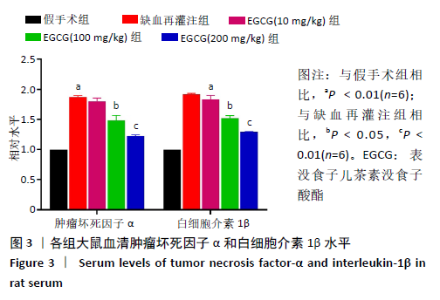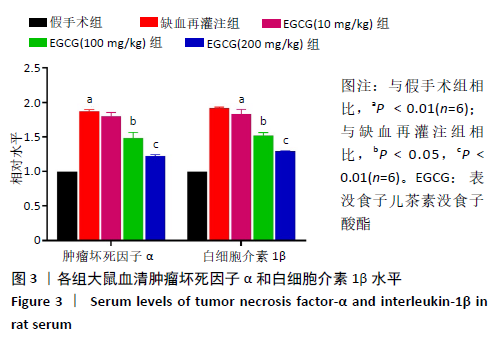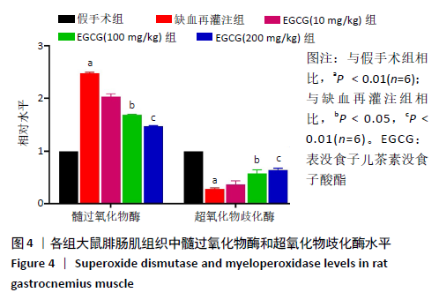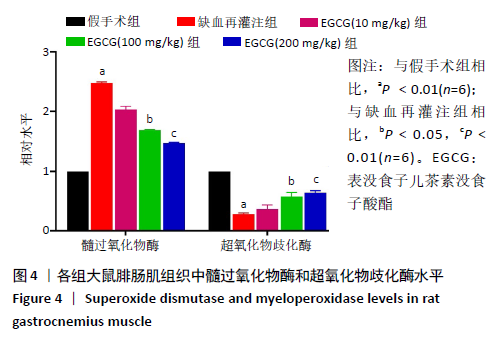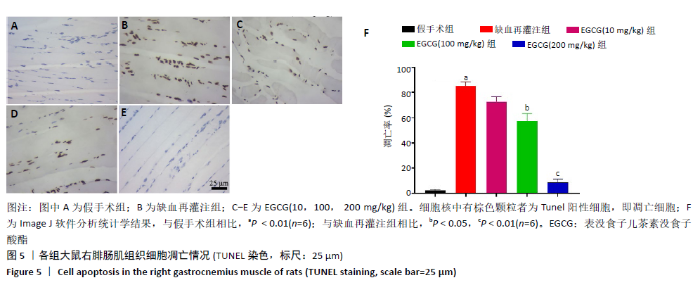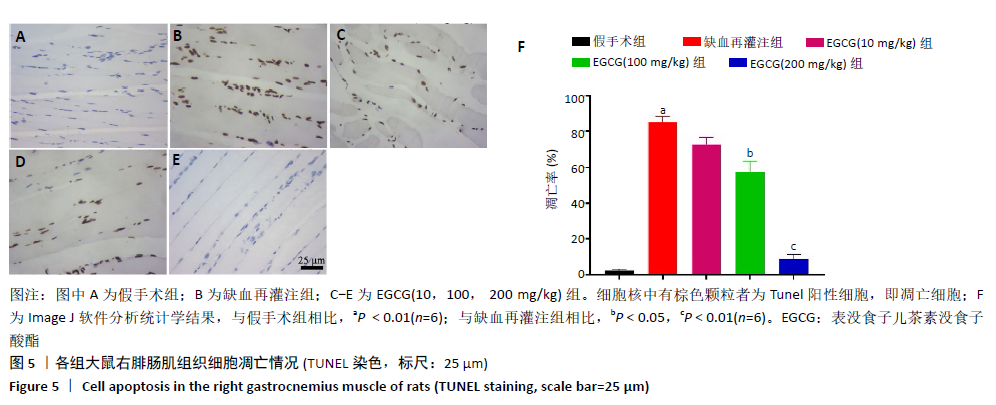[1] 李颖,孙中洋,闫浩,等.白果内酯对大鼠骨骼肌细胞缺血再灌注损伤的作用[J].中华创伤杂志,2020,36(7):659-663.
[2] WANG XT, TIAN Y, XU WX, et al. Protective Effects of Modeled Superoxide Dismutase Coordination Compound (MSODa) Against Ischemia/Reperfusion Injury in Rat Skeletal Muscle. Cell PhysiolBiochem. 2015;37(2):465-476.
[3] LI Y, JIANG J, TONG L, et al. Bilobalide protects against ischemia/reperfusion-induced oxidative stress and inflammatory responses via the MAPK/NF-κB pathways in rats. BMC MusculoskeletDisord. 2020;21(1):449.
[4] 阮思杰,阳富春,阳茂春,等.骨骼肌缺血后调适动态pH测量及模拟酸灌注减轻缺血再灌注损伤[J].中国组织工程研究,2017,21(16):2558-2564.
[5] DU JT, LI W, YANG JY, et al. Hydrogen sulfide is endogenously generated in rat skeletal muscle and exerts a protective effect against oxidative stress. Chin Med J (Engl). 2013;126(5):930-836.
[6] ZHU L, HUANG Y, PEI G. Study of L-arginine-nitric oxide pathway in ischemia-reperfusion injured limbs in rats. Chin J Traumatol. 2002;5(1):16-20.
[7] 姜洪军,任晓平.细胞凋亡与骨骼肌缺血/再灌注损伤[J].医学综述, 2017,23(10):1898-1902.
[8] HONG Y, ZHANG B, YU L, et al. Cell membrane integrity and revascularization: The possible functional mechanism of ischemic preconditioning for skeletal muscle protection against ischemic-reperfusion injury. ActaHistochem. 2017;119(3):309-314.
[9] 朱斌,宋航,陈晓光,等.用商品茶多酚制备高纯度表没食子儿茶素没食子酸酯的工艺研究[J].华中师范大学学报(自然科学版),2008,42(4): 574-577.
[10] 王丽,林昕,汪禄祥,等.茶叶中多种功能成分含量测定与分析研究[J].食品安全质量检测学报,2019,10(22):7779-7786.
[11] 赵峰,阙付有,梁京,等.儿茶素单体EGCG酶法修饰研究及其产物抗氧化活性评价[J].天然产物研究与开发,2015,27(3):490-495,533.
[12] 彭沙沙,夏丰,王进,等.三氯化钆对Sprague Dawley大鼠肝脏缺血再灌注损伤的影响及作用机制[J].中华肝胆外科杂志,2020,26(3):213-217.
[13] 卢中山,王伟,钟自彪,等.肝脏缺血再灌注损伤干预措施的研究进展[J].中华肝胆外科杂志,2019,25(11):871-874.
[14] 张铂,王兵,曹书华,等.表没食子儿茶素没食子酸酯对大鼠创伤性脑水肿保护作用的研究[J].中国中西医结合急救杂志,2015,22(4):402-407.
[15] 张玉琴,朱旭强,吴力新,等.表没食子儿茶素没食子酸酯对脑损伤小鼠认知和氧化应激的影响[J].中华实验外科杂志,2018,35(3):475-477.
[16] LI YW, ZHANG Y, ZHANG L, et al. Protective effect of tea polyphenols on renal ischemia/reperfusion injury via suppressing the activation of TLR4/NF-κBp65 signal pathway. Gene. 2014;542(1):46-51.
[17] KOCMAN EA, OZATIK O, SAHIN A, et al. Effects of ischemic preconditioning protocols on skeletal muscle ischemia-reperfusion injury. J Surg Res. 2015; 193(2):942-952.
[18] SIMON MA, TIBBITS EM, HOAREAU GL, et al. Lower extremity cooling reduces ischemia-reperfusion injury following Zone 3 REBOA in a porcine hemorrhage model. J Trauma Acute Care Surg. 2018;85(3):512-518.
[19] 李林,胡海姣,刁玉刚.损伤控制性复苏对低温失血性休克大鼠全脑缺血-再灌注损伤保护作用[J].创伤与急危重病医学,2019,7(2):82-84,87.
[20] 张艳平,张倩,阎玮,等.浅低温对大鼠脑缺血再灌注时皮质Mfn2表达的影响[J].中华麻醉学杂志,2019,39(11):1383-1386.
[21] 肖靖远,林飞,潘灵辉,等.地塞米松调控PI3K/AKT通路减轻肺缺血/再灌注损伤的作用及机制[J].中华危重病急救医学,2020,32(2):188-193.
[22] 施源,李宏军,王君君,等.血必净通过激活PI3K/Akt/mTOR信号通路减轻大鼠睾丸缺血再灌注损伤[J].中国病理生理杂志,2020,36(2): 329-335.
[23] 胡敏,於四军,刘惠亮.褪黑素对大鼠挤压综合征模型骨骼肌缺血再灌注损伤的影响[J].中国循环杂志,2017,32(z1):42.
[24] 王婷,冷玉芳,陈平,等.青藤碱对大鼠肢体缺血再灌注损伤及骨骼肌细胞Bcl-2和Bax表达的影响[J].中华麻醉学杂志,2016,36(9):1094-1097.
[25] 申震,朱付平,刘天举,等.桃红四物液对大鼠肢体缺血-再灌注损伤炎症因子表达的影响研究[J].中华中医药学刊,2018,36(2):374-377.
[26] RUZICKA J, URDZIKOVA LM, SVOBODOVA B, et al. Does combined therapy of curcumin and epigallocatechin gallate have a synergistic neuroprotective effect against spinal cord injury? Neural Regen Res. 2018;13(1):119-127.
[27] 王金妮,欧冰凝,梁钢.表没食子儿茶素没食子酸酯全乙酰化衍生物的合成及急性毒性试验[J].广西医学,2012,34(2):129-133.
[28] 李霄,张玄,王权成,等.儿茶素没食子酸酯预处理对大鼠肝脏缺血再灌注损伤的保护作用[J].中华肝胆外科杂志,2018,24(3):199-203.
[29] 丁华胜,王永剑,黄忠毅.丹参酮Ⅱ A对大鼠心肌缺血再灌注损伤中HMGB1、IL-1β表达及SOD水平的影响[J].中国中医急症,2020,29(5): 776-778,801.
[30] 周光居,张茂,干建新,等.MicroPET及MPO对大鼠ALI时肺内炎症反应评估效果的研究[J].中华急诊医学杂志,2014,23(4):399-401.
[31] 梁倩倩,田华,庄宝祥,等.脉络宁对兔肢体缺血/再灌注损伤过程中SOD及MPO的影响[J].中国药理学通报,2012,28(6):885-886.
|


